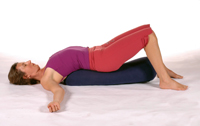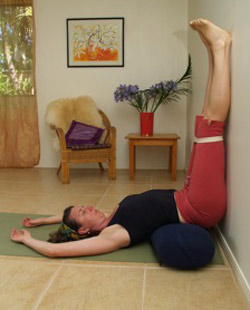
As we enter the season of coughs and colds, it’s time to enlist some natural strategies for strengthening our immunity. Along with dosing up on the garlic and popping the Vitamin C tablets, yoga can help provide some much needed protection against the nasty winter ‘lurgy’.
While the winter winds whistle, retreat indoors with some restorative poses that will help calm the nervous system and reduce your stress levels. Stress can erode the efficient functioning of your immune system, so a restorative practice could be just what the doctor ordered!
The following passive postures work to ease fatigue by opening the chest, refreshing the heart and lungs. They also help to clear congestion of the respiratory tract, useful for minimising the duration and intensity of colds and flu. Make sure you are clothed warmly or cover yourself with a blanket as you stay in either pose for anywhere between 4-20 minutes, relaxing and breathing deeply.

Well known New Zealand based yoga teacher, Donna Farhi, describes this pose as "pure ambrosia for the over-worked nervous system". According to B.K.S Iyengar it helps treat stress-related headaches and migraine, as well as relieving breathlessness, asthma, bronchitis and throat ailments.
It’s a passive inversion which offers all of the benefits of active inversions but can be practiced, without strain, when you are feeling tired and run-down.
With the inversion of the body, the diaphragm no longer has to work against gravity, which assists in a fuller exhalation, and, in turn, facilitates a deeper inhalation. This causes the heart rate to slow down and also helps decrease blood pressure.
"As the breath deepens the body receives a message that all is well," says Farhi. "And the positive feedback loop of this good news draws us into a deeper and deeper state of relaxation".
Method
Sit on a bolster or folded blanket, side on to a wall. Flip the legs up the wall to lie on your back. Shuffle your bottom in as close as possible to the wall. In effect, the tail-bone drops down between the space between the bolster and the wall, and the bolster supports the lower back.
Supported Setubandha Sarvangasana (Bridge pose)
This pose also encourages deep breathing by gently opening the thoracic spine, helping to strengthen the lungs. It drains fluid from the legs, reducing fatigue. It also quiets the mind relieving mental agitation and may help alleviate headaches.
Method

This is the simplest variation in which you sit on a single bolster and slowly lower your head and shoulders to the floor. Keep you knees bent, feet flat into the floor.
Variation B
Place one bolster adjacent to a wall and the second bolster a few inches away, and perpendicular. Lie lengthways along the second bolster and adjust the position of yourself and the second bolster such that you end up with your head and shoulders comfortably touching down on the floor. The soles of feet should be resting against the wall, which feels very nurturing.
